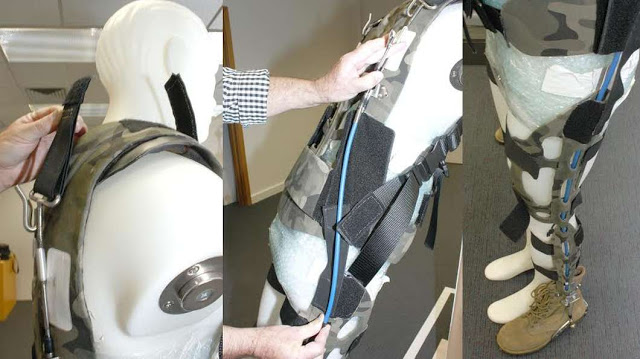Australian researchers have developed a simple, lightweight (3 kg) fully-passive exoskeleton. This system uses Bowden cables to attached to a rigid backpack frame. The cables run down the back and legs to the base of the boot and transfer approximately two thirds of the backpack load to the ground
. This load force bypasses the user’s body, reducing compression forces from the backpack load through the torso and legs.
The benefits of such a system compared to a powered exoskeleton include: simplicity, no requirements for heavy batteries; low cost; easier to integrate with the user and equipment and redundancy when no longer required – remove and add to pack.
The development is at a proof-of-concept stage with early testing showing encouraging results. However, the biomechanics of the system require extensive refinement to ensure it is integrated optimally with the soldier and truly fit for purpose.
While the technology is being developed around use in the military it might be applicable to many civilian scenarios such as firefighting, trekking and personal load carriage roles that require assistive technology.
Passive Exoskeleton
Bowden Cable
The US unpowered ankle exoskeleton that reduces the metabolic cost of walking by approximately 7 percent. The results are roughly the equivalent of taking off a 10-pound backpack, and are equivalent to savings from exoskeletons that use electrically-powered devices.
Walking with a passive-elastic ankle exoskeleton. An unpowered clutch engages a spring in parallel with the Achilles tendon when the foot is on the ground, offloading the calf muscles and making walking easier. Credit: Stephen Thrift, North Carolina State University

Brian Wang is a Futurist Thought Leader and a popular Science blogger with 1 million readers per month. His blog Nextbigfuture.com is ranked #1 Science News Blog. It covers many disruptive technology and trends including Space, Robotics, Artificial Intelligence, Medicine, Anti-aging Biotechnology, and Nanotechnology.
Known for identifying cutting edge technologies, he is currently a Co-Founder of a startup and fundraiser for high potential early-stage companies. He is the Head of Research for Allocations for deep technology investments and an Angel Investor at Space Angels.
A frequent speaker at corporations, he has been a TEDx speaker, a Singularity University speaker and guest at numerous interviews for radio and podcasts. He is open to public speaking and advising engagements.




